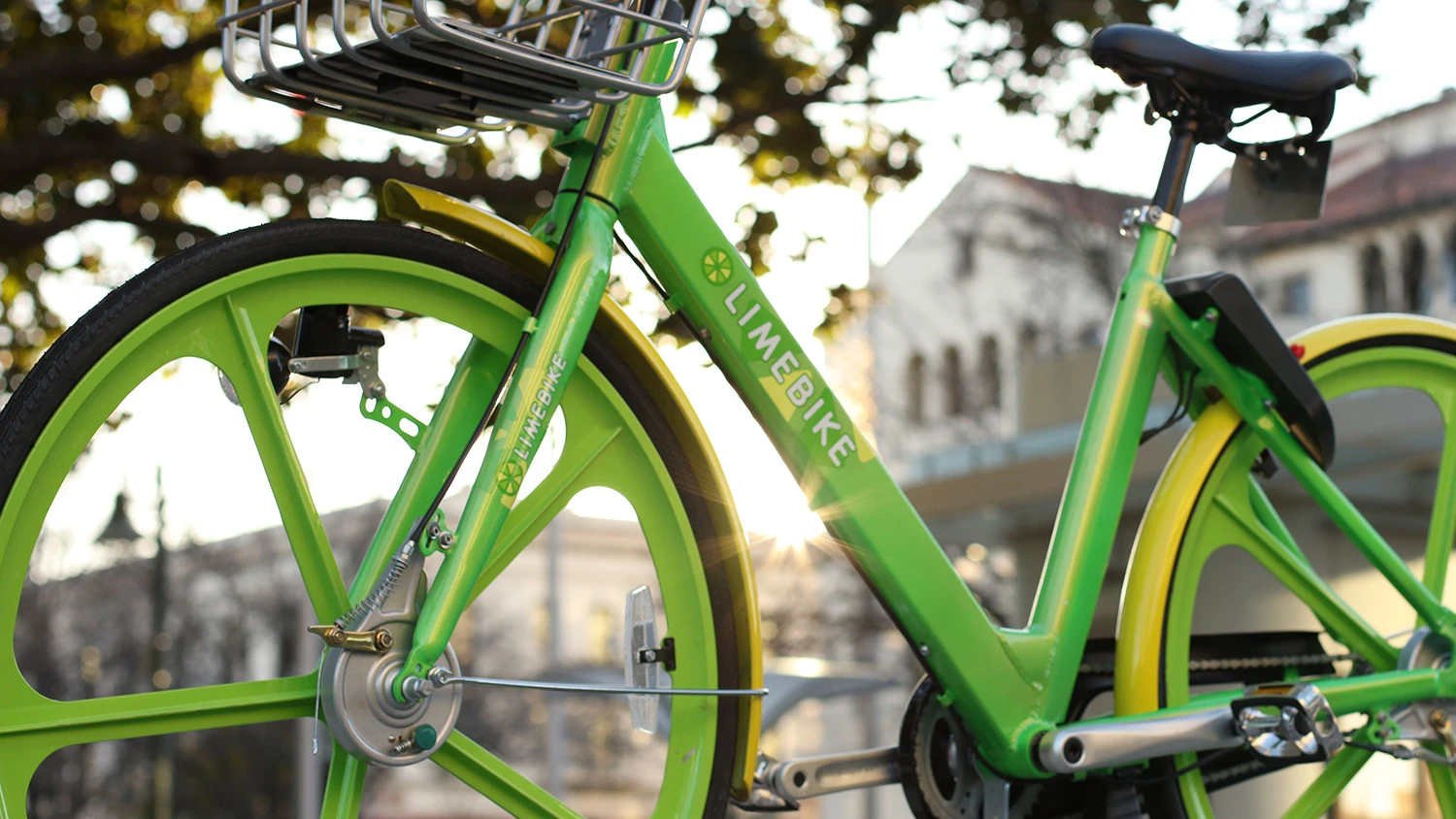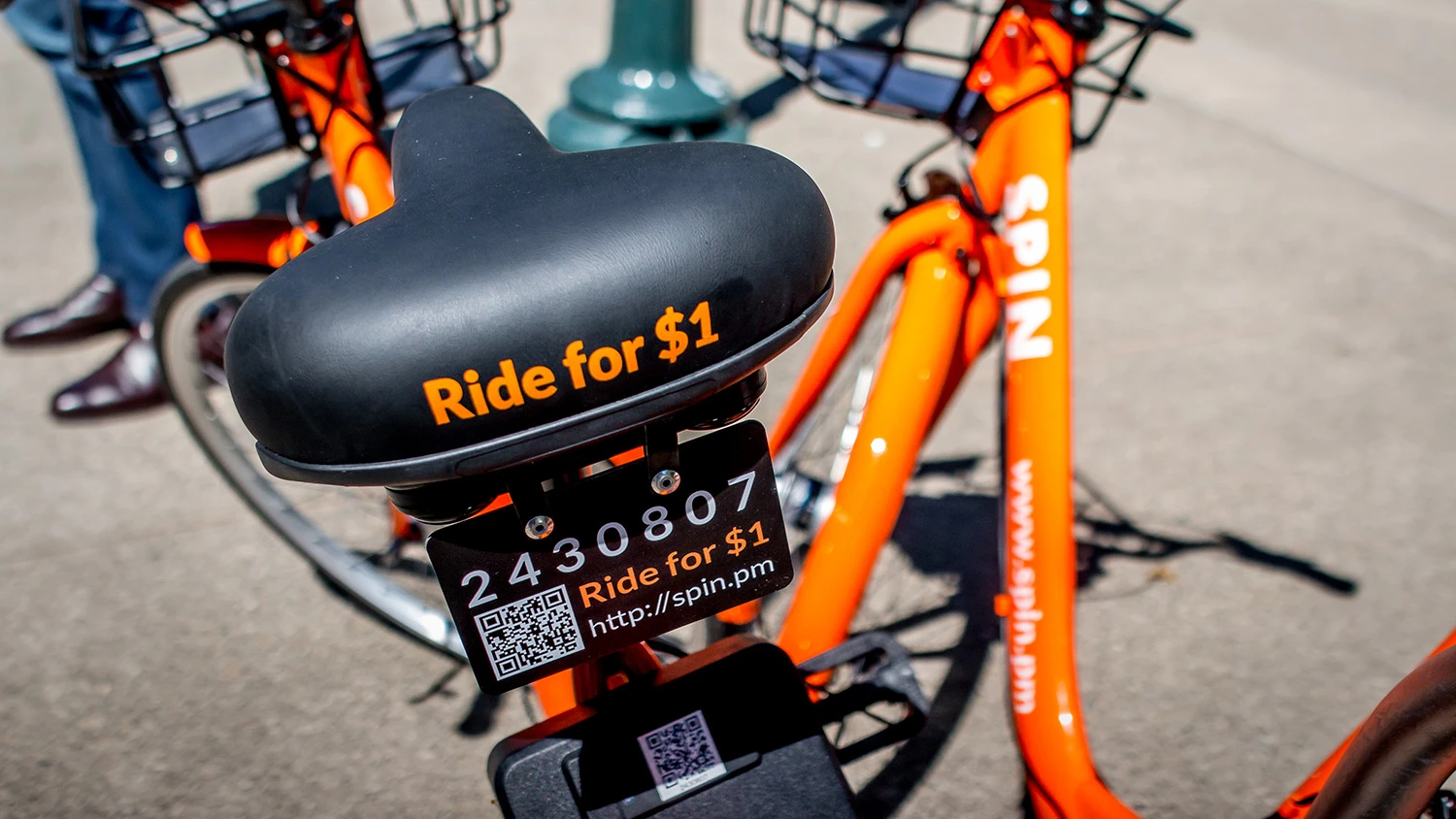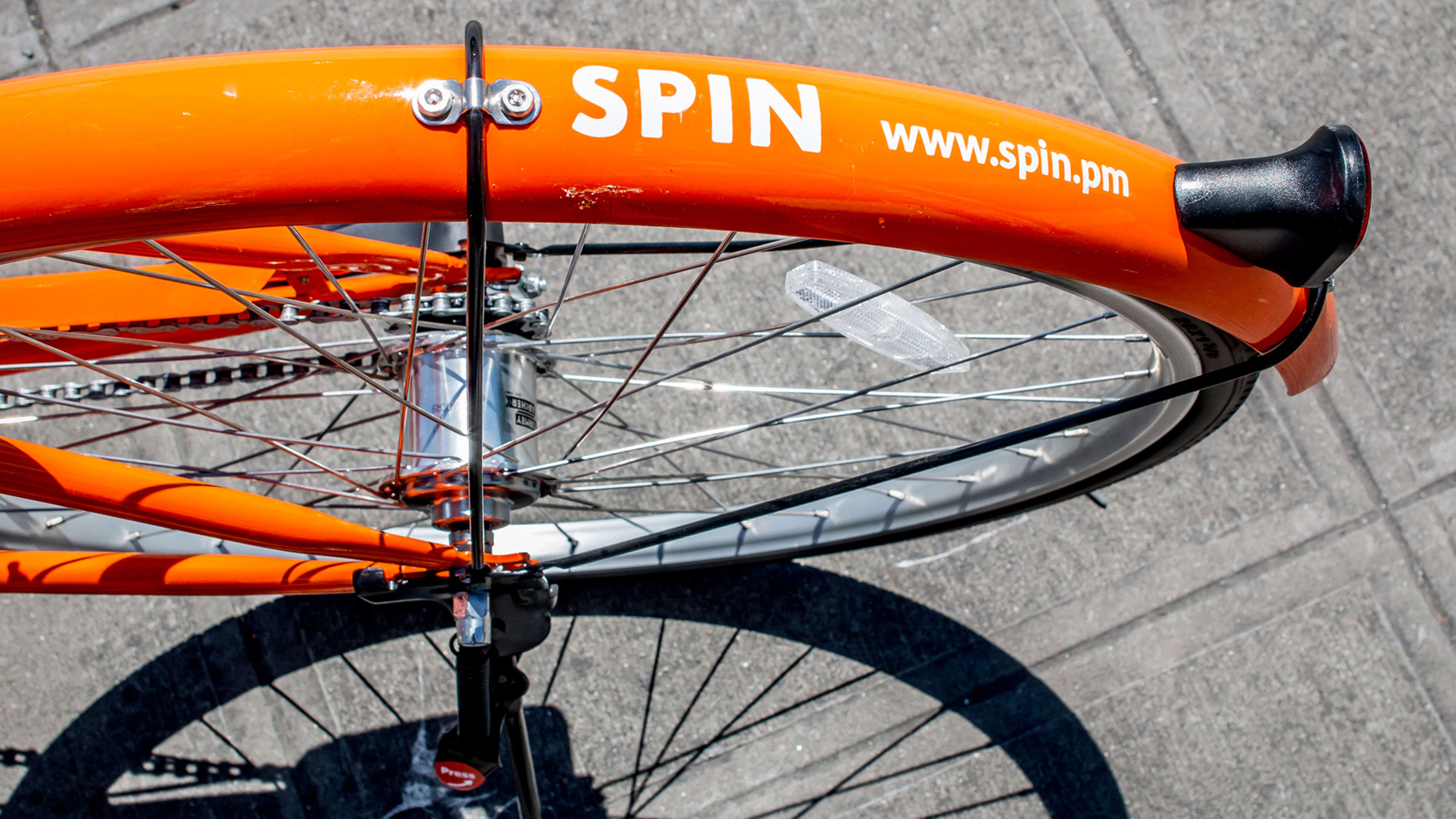In late July, residents of Seattle started to notice hundreds of seemingly abandoned lime green and bright orange bikes appear around the city. These vehicles had old-fashioned front baskets bedecked with surprisingly modern solar panels, and were spotted all over town in bike racks, on parking strips, and leaning up against buildings.
This wasn’t a marketing campaign—or a sneaky alien bicycle robot Trojan Horse attack—but rather the near-simultaneous launch of Spin and LimeBike, two competing bike-on-demand services that breezed through the city’s fast permitting system to deploy hundreds of bikes. Cooperating with authorities on regulation may seem very last century, but “we never go into a city without notifying a city,” says LimeBike’s CEO and cofounder Toby Sun.
https://www.instagram.com/p/BWn12f7FSyH/
Both services charge $1 for each 30 minutes of use, use smartphone apps to handle rentals, and have a GPS/cell combo package that controls an unlocking mechanism on the rear wheel, eliminating the need for fixed-location docks used by many cities’ bike-sharing services. The bicycles may be used and left anywhere within city limits. Picking up or moving a locked bike causes it to beep an alarm. Both companies also offer a $29-a-month commuter plan: LimeBike’s plan covers up to 100 trips, while Spin allows unlimited use. (Riders must provide their own helmets, which are required by law in Seattle.)
Each firm launched with 500 bikes, but both have staggered permits that let them gradually release more. LimeBike doubled its fleet to 1,000 on August 7. In September, the companies can each have 2,000 bikes rolled out, and then an unlimited number starting in October. Both firms’ chief executives say they expect to deploy (very roughly) around 10,000 bikes to serve a city of 700,000 residents, 250,000 daily commuters, and 38 million annual tourists.
Dockless bike-sharing was pioneered in China, where millions of bikes blanket hundreds of cities. Two of those firms, Mobike and Ofo, have plans to enter the U.S. and Europe, and Seattle could be one of the markets either or both join.
https://www.instagram.com/p/BXZB76hB_Tj/
LimeBike says its bikes got 10,000 rides in their first week of availability; Spin hasn’t released an exact number, but says it saw several thousand rides in the giddy first days of operation. That’s impressive given that a cyclist has to download an app, create an account, register a credit card (or use Apple Pay or Android Pay with Spin), and deposit credit to get started. I found both apps neatly designed and the intake process and first rental straightforward, typically a high point of friction to gain users. Maps in the apps show the location of available bikes, which, unlike with car-sharing services, can’t be reserved. You end your bike journey by sliding a lock lever into place.
Every bike functions as a mobile advertisement, with information about using the service and obtaining the app. Sun notes that’s led to nearly all app downloads coming from offline referrals, allowing a different strategy than most software-based companies. “All the traditional marketing dollars can be saved to improve the product,” he says.

Bike Sharing 2.0
LimeBike’s and Spin’s launches follow the demise of a bike-sharing service called Pronto in Seattle, which relied on docking stations, typical in many successful deployments, including the popular Citibike in New York City and operations in 10 other cities by Pronto’s original developer, Motivate.
Pronto’s Seattle rollout in 2014 was followed by a number of problems relating to funding and other issues—including a $10,000 fine for an accidental ethics violation—that left it stalled with 500 bikes and 54 far-flung stations, even after the city purchased the system for $1.8 million in 2016. Blake Trask, the senior policy director at Cascade Bicycle Club, a cycling advocacy nonprofit, says that the service never got past its pilot phase and would have benefited from more densely placed docks. Seattle shut it down in January 2017.
Spin’s CEO, Derrick Ko, credits Pronto with paving the way for the regulatory infrastructure and bike-sharing acceptance that allowed his firm and LimeBike to obtain stunningly rapid approval. “They really changed the public perception of how biking can fit into commutes,” he says. It may help that the new services didn’t ask for a penny from the city, and only require one asset: permission to park on public rights-of-way.
Shefali Ranganathan, the executive director of Transportation Choices, a nonprofit that advocates for non-car based options, says that Seattle bucked its usual reputation of studying problems into the ground. “Rather than pontificating, this is a good example of government being nimble,” she says.
Nimble is the right word for both firms, too. Spin was founded in December 2016 and has raised $8 million in initial funding; LimeBike started up in January 2017, and has $12 million in first-round investment. Your hard-bitten correspondent found the fit and finish of the apps, mechanical/electronic locking systems, and bicycles remarkably mature given that brief time frame. It may help that the companies didn’t go for bespoke bikes, but turned to established suppliers to customize existing designs.
LimeBike now operates in six cities and college campuses, including the University of North Carolina at Greensboro; Spin is in three plus a pilot. LimeBike’s Sun says the company hopes to be in 20 cities or schools by the end of the year. Spin’s Ko is more reserved about plans, but the company has both cash and momentum, and can’t give up the first-mover advantage in new markets to LimeBike, with new entrants on the horizon.

The Road Uphill
With both services, customers’ ability to leave bikes anywhere they want creates a rider-centric distribution of cycles around the city that the company rejiggers with crews that “rebalance” bikes by scooping them up and driving them to in-demand locations. Both companies have released heat maps of the early days of operation that show a significant concentration in the downtown area and environs, which is home to tens of thousands of Amazon employees. Also popular is the formerly funky neighborhood of Fremont, which includes operations of Google, Adobe, Getty, and the Paul Allen Brain Institute, among other technical and biotech firms.

Those concentrations match up with the densest populations of Seattle workers and tourists, but topography is also a factor. Seattle is a city of many hills: It’s easy to find elevation distances of 300 feet or more between popular neighborhoods due to hills and ridges. The city’s founders lessened that a bit by using hydraulics to demolish a cliff into a tapering decline, but we’re still rather hilly.
The majority of the early bike-share rides took place in relatively flat areas, perhaps in part because the services’ cycles aren’t modern, sleek speed machines. Rather, they remind me strongly of the three-speed my mother owned in the 1970s, though they’re not nearly as heavy or ungainly. Spin’s bike is an actual three-speed, while LimeBike offers eight gears. (The bikes use just a few gears partly for cost, partly for simplicity for casual riders, and partly to keep top speeds lower.) In riding some hills in my neighborhood, LimeBike had the advantage of downshifting lower, but Spin says it’s already rolling out revised bikes with more hill-friendly gearing in response to customer feedback. Spin will also be shifting from a side kickstand to a center-mounted one for better stability.
The companies may ultimately offer bonuses, as some Chinese firms do, for users who take trips that rebalance distribution. “We could develop incentives to get people to ride uphill,” says LimeBike’s Sun. That would help with areas like Queen Anne Hill, which is outlined as a big circle to the northwest of downtown. It’s a hill so steep it once had a remarkable counterbalance system to get streetcars up its south face, north of downtown, similar to that used with cable cars in San Francisco.

Both companies also want to introduce electric-assist bikes when they can. It’s a matter of cost and the state of technological development. Sun notes, “If you only have a million dollars, you can probably get 10x more bikes, to serve more people” with manual bikes. Spin’s Ko says he’s holding out at least for now for better batteries and charging systems, as there’s no universal standard as with electric cars.
The conventional bikes won’t stand still, however. Spin and LimeBike’s CEOs emphasized continuous and iterative engineering across all their operations, including the cycles. Sun says his firm will have quarterly revisions to bikes, rolling some features into older models as upgrades. For instance, early customer feedback led to incorporating a cell-phone mount into the 500 bikes it deployed in early August, and it will retrofit older models with this mount as well.

A Spoke In A Larger Hub
Bike-sharing, like car-sharing, isn’t intended as an end-to-end trip replacement, nor necessarily to eliminate personal bike (or car) ownership. Rather, it’s a way to bridge the gap between other forms of transportation, including both driving and mass transit. Seattle’s people movers are run by Sound Transit, a multi-county sprawling octopus of long-distance heavy rail, intra-city light-rail still in early stages, and regular, express, and rapid-ride buses. The city also has a growing streetcar network.
But people are only willing to walk a limited amount to reach a transit stop, although there’s a fair amount of dispute about precisely how far that is. Whatever that distance is for any given person, it can often be the difference between a public-transit commute and one done by car. Between traffic, parking cost, and alternative modes of transportation, Seattle already only sees 30% of its downtown commuters arriving solo by car. (Just 9% carpool or vanpool.)
Adding on-demand bikes can shift the best and fastest route for a regular commuter from car to mass transit. “This is more transit than bike, even though it look like a bike, feels like a bike,” says Cascade’s Trask. “We’ve always seen a bike share as very much part of a multi-modal transportation system,” agrees Transportation Choices’s Ranganathan.
Your correspondent has considered a co-working space run by friends seemingly not far from his house in Seattle. But according to Google Maps, a commute by light rail, by bus, or bike takes 45 minutes. The drive is 20 to 30 minutes, not including parking time. Adding a bike share makes the light-rail route suddenly reasonable, reducing 25 minutes of walking on each end to something closer to 10 minutes, turning a well-timed commute into 30 minutes each way.

A big issue will be access to bike-sharing for those without smartphones in a city that wrestles with the issues of equity and skyrocketing housing prices, where technology advances seemingly designed for everyone leave those below a certain income behind.
Ranganathan says that bike-sharing could be particularly useful for people entirely reliant on transit who work outside the hours in which the most service is offered: “Transit doesn’t work for low-income communities in all instances, especially if you don’t work a nine-to-five job. Yes, the bus will get you there, but how do you get back?” She sees access to low-cost bike-sharing as a possible route.
LimeBike’s Sun says the company is about to take a step in that direction, adding the ability for people without a smartphone or a bank account to deposit credit through a partner institution, and then use a phone call or even email to unlock a particular bike. By the end of the year, he hopes to have bikes on the road with key pads, allowing access if you don’t have a phone (or your battery has died).
https://www.instagram.com/p/BST9QQvhumw/
Safer Streets
Advocates for multi-modal transportation cite bike-sharing as a way to make biking a safer part of that system. Bike-sharing has the potential to bring thousands more riders onto the streets on a regular basis. “What you see in places where bike ridership goes up, safety outcomes—serious injuries and deaths—go down. There’s a phenomenon known as safety in numbers,” says Trask of the Cascade Bicycle Club.
That could then produce a virtuous cycle: More riders producing safer roads encourages more riders. Increased usage could help shift how roads are used. “Downtown core needs more of that space allocated for the thing that is more efficient and the fastest to get around,” Trask says. In other words, cycling. Already, Seattle has been imposing “road diets” on neighborhood streets (shifting four-lane roads to two plus a center turn line), reducing speed limits, and adding fully protected bike lanes. This would be part of that same evolution.
Spin’s Ko, who previously worked as a product manager at Lyft, says that “cars are no longer a sustainable way to help people move around cities.” While it’s a good marketing slogan, it’s also the driving philosophy of Seattle and its region. Spin and LimeBike picked a good city to kick off from.
Recognize your brand’s excellence by applying to this year’s Brands That Matter Awards before the final deadline, June 7.
Sign up for Brands That Matter notifications here.
